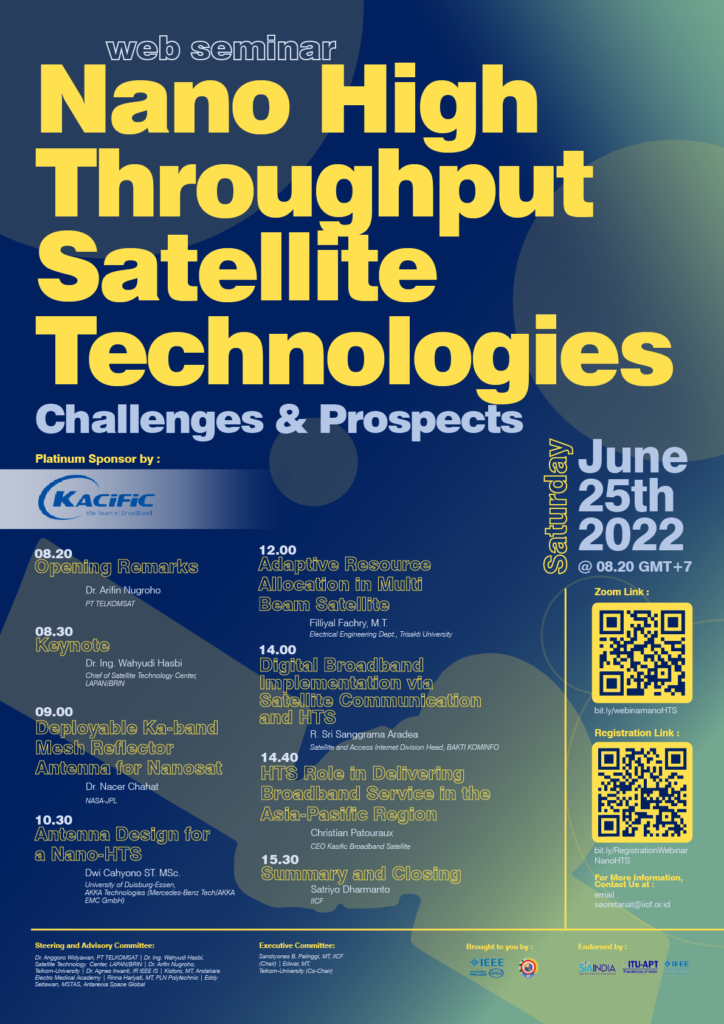WEB-SEMINAR ON THE NANO HIGH THROUGHPUT SATELLITE TECHNOLOGIES

The use of the satellite for conveying broadband traffics is increasing as High Throughput Satellites (HTS) are proliferated to cover almost all the three continents. This most disrupted phenomena owe to multitude of enablers such as the multi-beam-satellite-antennas technology, advances in Ka-band microelectronics and software defined radio, as well as the broad frequency spectrum availability. It seems that the current state of the art say that literally the HTS can achieve 1 Terabits-per-second capacity. For realizing that sizeable payloads there will be generally at least a 25 kW (kilo watt) spacecraft bus required to be the geostationary platform. One may question whether the same payload technology could have been applied at NGSO (non-geostationary orbit) satellites with the objective to deliver broadband Internet services with less latency.
Meanwhile, after the acceptance of the small NGSO satellites for Narrow Band communications, the researchers are now working on using the same platform for conveying the broadband Internet signals. New initiatives are coming, as the Starlink satellites are being deployed on an NGSO Constellation Satellites system with a huge-to-be number of spacecrafts. Suitable antennas should have been designed to allow multibeam solution can be realized in a Nanosat or Cubesat platforms with one of the design objectives would certainly be minimizing the antenna and RF electronics masses. Incorporating the Software Design Radio techniques by applying certain integrated electronics may have a good potential for reducing the mass influence. Other question which may be posed would be, what will be the most suitable attitude control technique allowing the multibeam antennas with some delicate impact to the nanosat dynamics, to be in a stabilized pointing position ensuring a good communication links.
This one-day web-seminar will propose discussion by Nanosat/Cubesat experts and designers in dealing the above design challenges, as well as a panel discussion on real implementation of HTS in Indonesia.
This web-seminar will be organized via a Vid-Con mode, jointly hosted by Indonesia GRS/AES Joint Chapter of the IEEE and the Indonesia-ITU Concern Forum (IICF). The event is endorsed by Satellite Industry Association of India, ITU-APT Foundation of India and IEEE IS IR and will be organized by the Satellite Communication and RADAR Laboratory of the Telkom-University, as well as supported by LAPAN/BRIN and BAKTI Kominfo with PT Telkomsat as one of the main sponsors. The targeted participants will range from across the telecommunication industry, the academia and research community, as well as members of IEEE and IICF of both local and abroad.
Webinar Schedule: Saturday, 25 June 2022, 08.20 – 15.00 GMT+7 (Jakarta Time)
Registration link: https://bit.ly/RegistrationWebinarNanoHTS
| No | Name of Speaker | Topic of Talk | Duration (GMT+7) | Notes |
| 1 | Dr. Nacer Chahat, NASA-JPL | Deployable Ka-band Mesh Reflector Antenna for Nanosat | 09:00 – 10:30 | Confirmed |
| 2 | Dwi Cahyono ST. MSc. University of DuisburgEssen, AKKA Technologies (Mercedes-Benz Tech/AKKA EMC GmbH) | Antenna Design for a Nano-HTS (THz, sub-mm wave communication) | 10:30 – 12:00 | Confirmed |
| 3 | Filiyal Fachry, M.T., Electrical Engineering Dept. Trisakti University | Adaptive Resource Allocation in Multi Beam Satellite | 12.00 – 13.30 | Confirmed |
| 4 | R. Sri Sanggrama Aradea, Satellite and Internet Access Division Head, BAKTI KOMINFO | Digital broadband implementation via satellite communication and HTS | 14.00 – 14.40 | Confirmed |
| 5 | Christian Patouraux, CEO, Kacific | Broadband Satellite HTS roles in delivering broadband service in the Asia-Pacific region | 14.40 – 15.30 | Confirmed |
